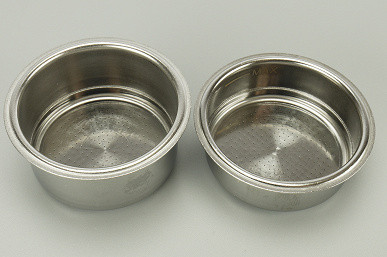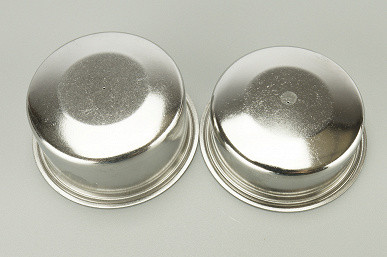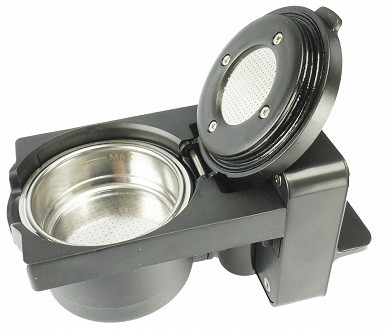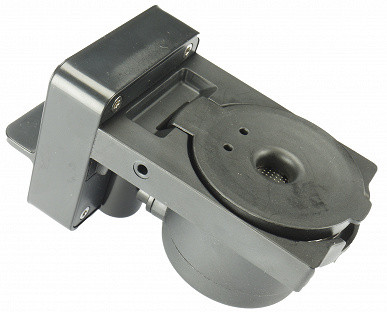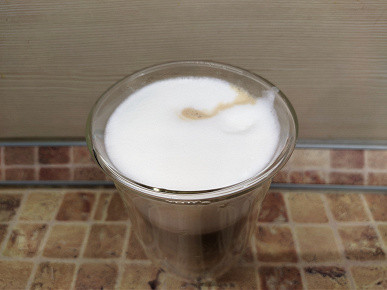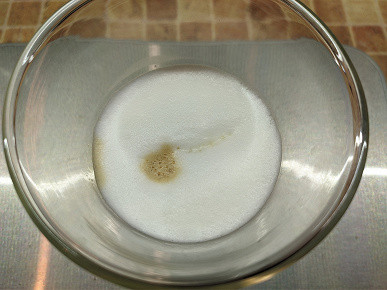When testing home coffee makers, we often come across various variations of classic models: drip coffee makers with a jug, horn coffee makers for espresso, and capsule coffee makers for quick coffee from capsules. We have also come across combination models that combine the functions of a horn and drip coffee maker, as well as devices with an integrated coffee grinder.
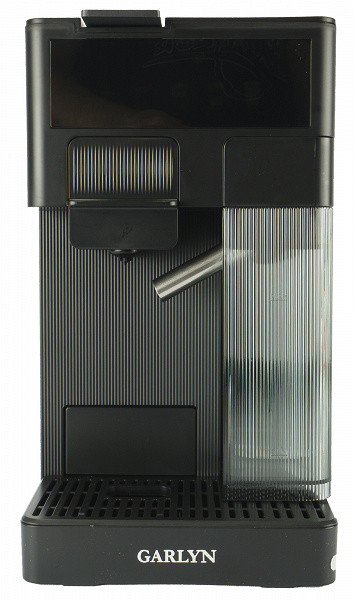
Today we are testing the Garlyn Barista Compact model, which is a coffee maker with a cappuccino maker function, but without a traditional portafilter. I wonder how this is possible and who it might be suitable for? Let's find out.
Characteristics
| Manufacturer | Garlyn |
|---|---|
| Model | Barista Compact |
| Type | horn coffee maker with automatic cappuccino maker |
| Country of origin | China |
| Guarantee | 1 year + 1 year upon registration |
| Service life * | 3 years |
| Declared power | 1150-1350 W |
| Body material | plastic |
| Tank capacity | 1.6 l |
| Milk jug capacity | 0.4 l |
| Pressure | 20 bar |
| Control | electronic, touch buttons |
| Weight | 5.1 kg |
| Dimensions (W×H×D) | 173×315×295 mm |
| Length of network cable | 0.62 m |
* Contrary to popular belief, this is not the period after which the device will necessarily break down. However, after this period, the manufacturer ceases to bear any responsibility for its functionality and has the right to refuse to repair it, even for a fee.
Equipment
The device arrived for testing in two packages. First, we received a thick box made of technical cardboard with the brand and model name, and inside we found a bright and beautiful cardboard box in orange and black colors. This approach is obvious: household appliances are often bought as gifts, and the second box allows you to unpack the coffee maker immediately before giving it, without worrying about damaging the festive packaging during transportation.
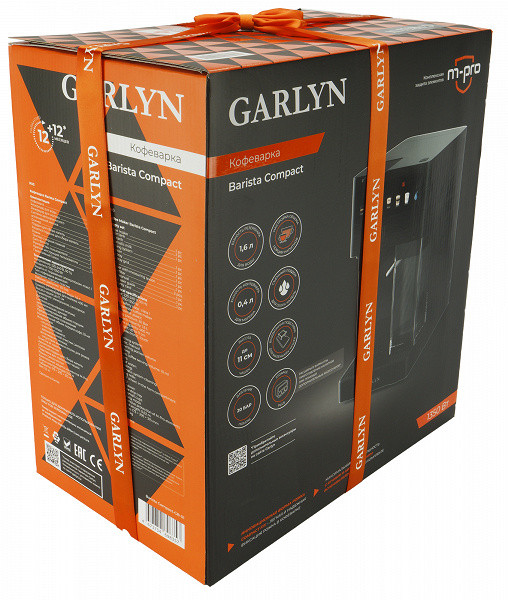
Bonus — a smart orange gift ribbon. It will cost pennies to produce, but the box will look ten times more festive and elegant.

The front side of the «front» box shows the device on a black background, and also indicates the main characteristics of the model.
On the side edges there is brief technical information, information about the manufacturer and a QR code for going to the Garlyn website.
Inside the box we found:
- the coffee maker itself
- two filters (for 1 and 2 servings)
- automatic cappuccino maker (jug)
- removable cappuccino maker
- plastic tamper
- cleaning brush
- operating manual, brief instructions and warranty card
All components are packed in protective polyethylene bags, and printed materials are placed in a separate plastic bag. For reliable fixation, all elements are packed in corrugated cardboard forms.
At first glance
At first glance, the coffee maker leaves an excellent impression. However, the first impression can be deceiving: after unpacking the box, we expected to see a full-fledged machine with a built-in coffee grinder, judging by the form factor and dimensions of the device. In fact, we had a «horn» coffee maker with an automatic cappuccino maker. It seems that the developers used the case from an automatic coffee machine, but with different filling.
Nevertheless, this does not spoil the overall impression. The body of the coffee maker is made of high-quality matte plastic, on which traces of grease are visible, but there are almost no fingerprints. All the elements look like a solid five, especially considering that this is a budget model.
Now let's take a closer look at the device.
The body of the coffee maker is completely made of black matte plastic, and the additional elements are also plastic.
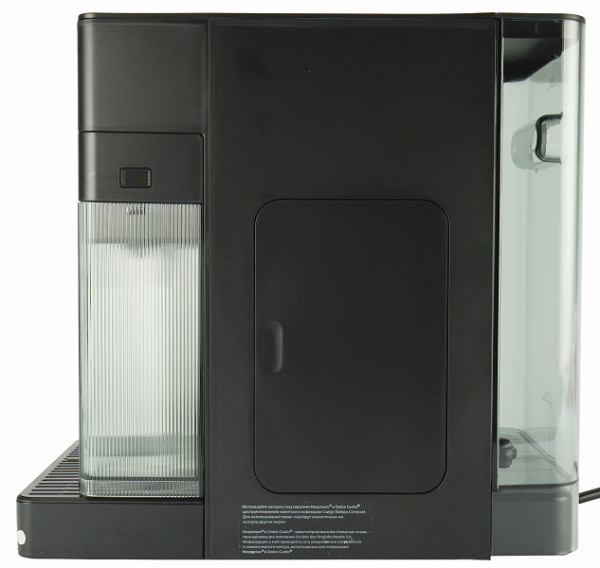
Even the cup holder, which is usually metal, is made of plastic in this model. Despite this, the device does not give the impression of cheapness. On the contrary, it looks more expensive than you would expect from its price.
There are several noticeable elements on the front panel. At the top is a color display with touch buttons, which we will look at in detail in the section on controls. Below the display, on the left, is a removable filter unit, and just above it is a metal lever that locks the unit in place. When the lever is down, the filter unit cannot be removed.
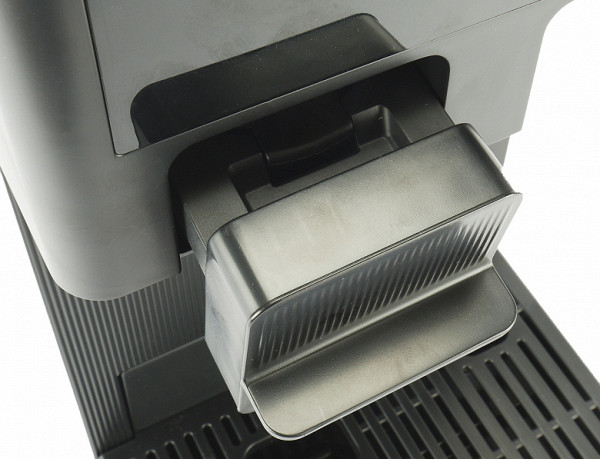
The lever is slightly springy, making it easy to use: it folds out easily and requires only a little effort to lower it back. To avoid metal knocking against the body, the lever has a soft soft-touch pad, which improves tactile sensations and makes working with the device more comfortable.
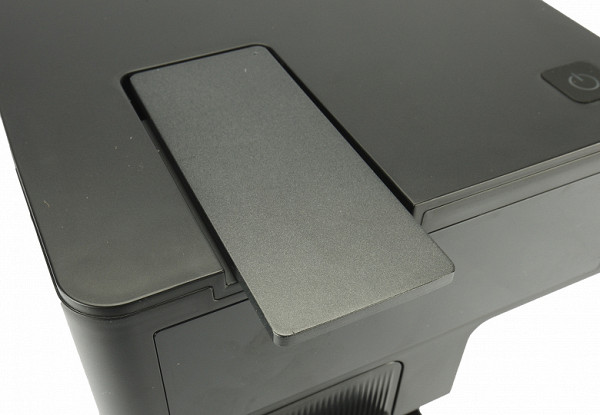
Now the main feature is revealed: instead of a standard espresso filter, you can use adapters for Nespresso or Dolce Gusto capsules, which, however, must be purchased separately.
When you remove the filter together with the unit, you can see a special needle for piercing capsules. This needle goes down when you press the lever and goes up when you need to remove the used capsule or used coffee.
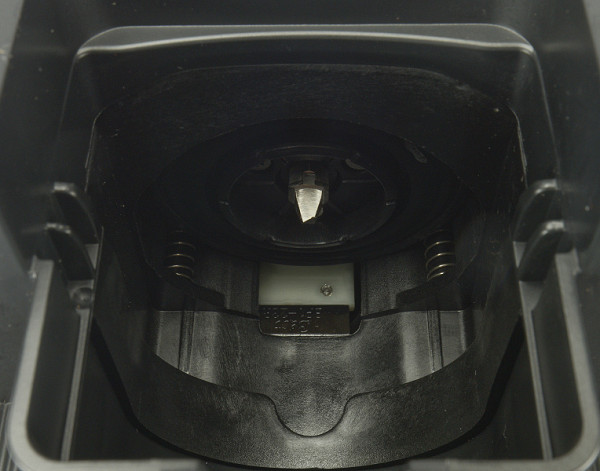
There is no stand for storing and warming cups in this model. On the top of the coffee maker there is only a button for turning on the device. The button is rubber, soft to the touch, easy to find in the dark, and pressed with a light click. Those who value tactile sensations will be pleased.
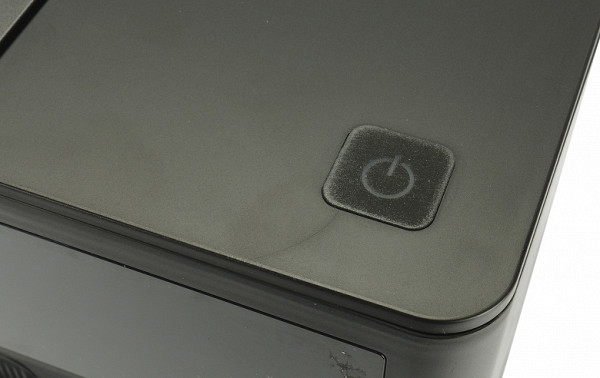
The bottom of the coffee maker has rubber feet to prevent slipping and a sticker with the model number and technical specifications. There are also ventilation holes. There is no compartment for storing the cord: the short cord (0.6 m) is simply brought out from the back of the device.
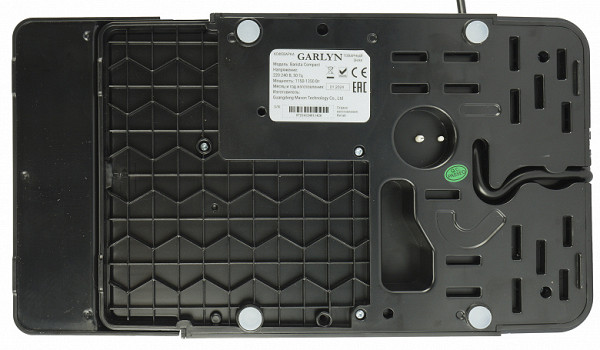
The cups are placed on a plastic stand with a container for collecting drips. Above the main stand there is a second, smaller one, designed for low cups or mugs. This stand is recessed into the body, has a spring mechanism and extends when pressed. When pressed again, it hides back and is fixed inside the body.
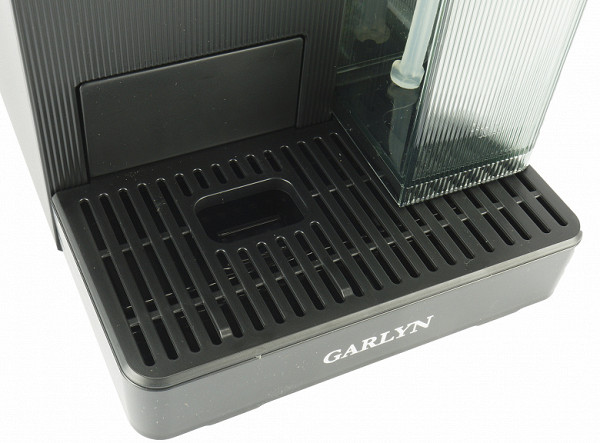
Thus, the coffee maker allows you to use dishes up to 11 cm high (without an additional stand) or 7 cm (with a stand). The height was measured to the spout of the cappuccino maker. If you prepare a drink without milk, the height of the dishes can be up to 13 cm without a stand and 9 cm with it.
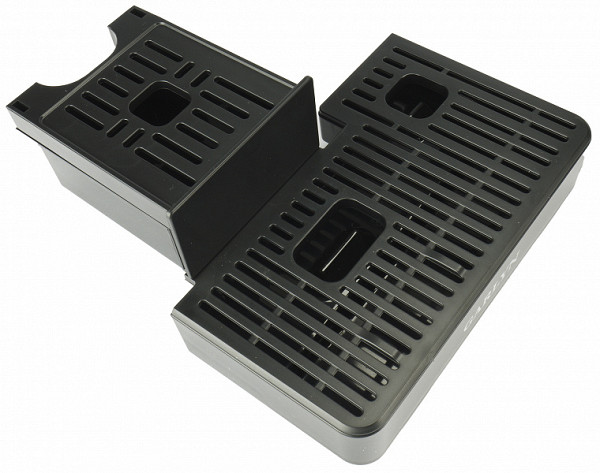
This model does not have a float or other way to remind the user about the accumulation of liquid in the tray.
On the right side of the coffee maker there is a removable frother, which is connected to the device via a plastic adapter. The frother can be easily detached (for example, to put the rest of the milk in the refrigerator) or removed if you do not use milk in coffee drinks.
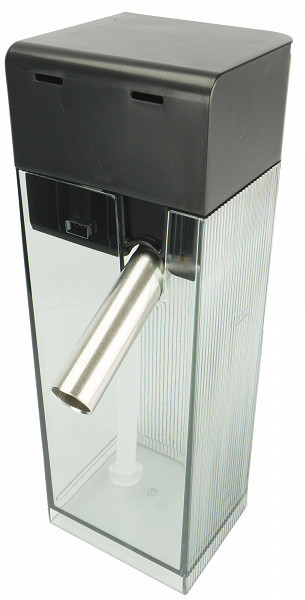
The body of the jug is made of plastic and has a Max mark at 400 ml. Inside there is a plastic tube for feeding milk, and the cappuccino maker (frother) itself is located inside a massive lid. The angle of the bell for feeding milk foam, unfortunately, is not adjustable.
The cappuccino maker works on a principle similar to automatic coffee machines: milk is fed through a plastic tube, foamed inside the lid of the jug and then fed through the bell directly into the cup.
Note that the front panel of the coffee maker and the jug are made in a single «striped» style, which has a positive effect on the appearance of the device.
On the right side of the coffee maker there is a large hatch that opens and closes with a simple press. Usually, behind such a door you can find a removable brewing unit, but this model does not have it. Instead, behind the door is a removable cappuccino maker-steamer for manual milk frothing. It can be installed instead of a jug and used with a pitcher to froth milk manually.
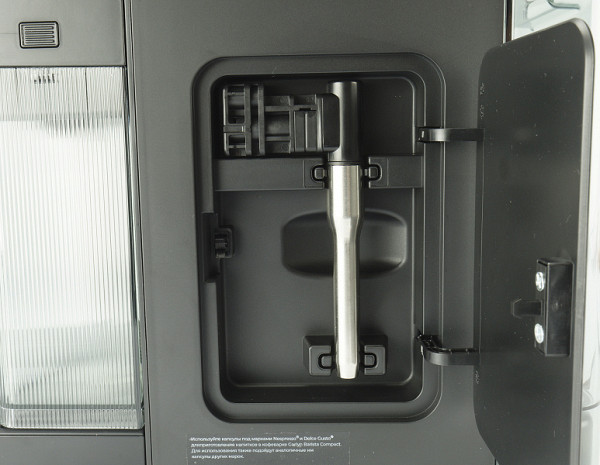
The manual cappuccino maker includes a plastic adapter for connection to the coffee maker and a removable metal tube with a plastic part inside. This time, it is possible to slightly adjust the angle of the cappuccino maker. When manually frothing milk, the optimal height of the pitcher is 10-11 cm.
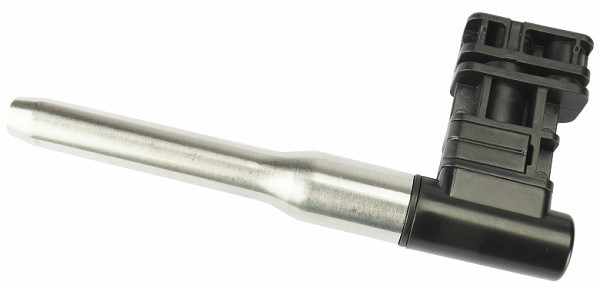
The removable 1.6-liter water container is made of darkened plastic and is located at the back of the coffee maker. To remove it, simply pull it up using the special recessed handle on the back.
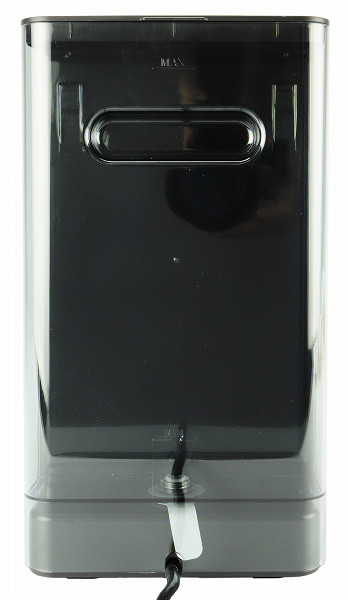
However, you probably won't have to take it out too often: the container has a removable lid, so you can simply add water as needed.
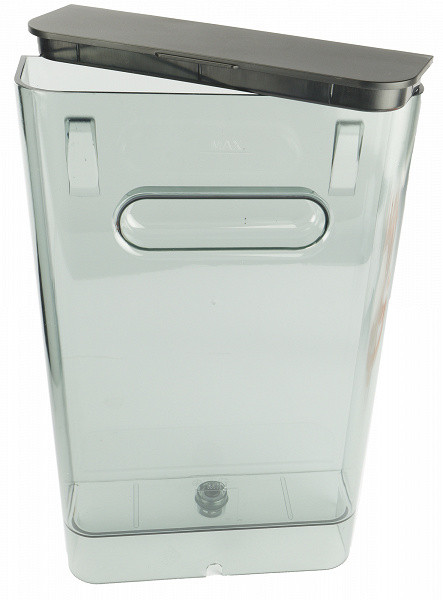
The Min and Max marks are on the back of the container, which means that, unfortunately, you won’t be able to see them from the side.
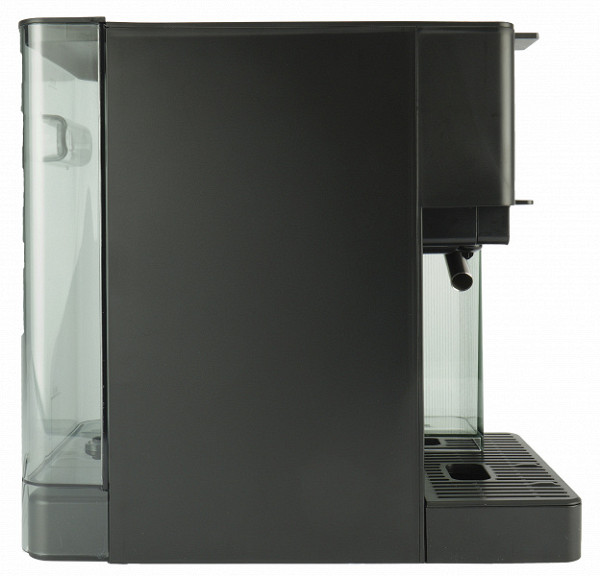
Water is supplied to the coffee maker through a valve at the bottom of the container, which is equipped with a simple mesh filter. This opening is initially closed with a special plug, which should be removed after unpacking.
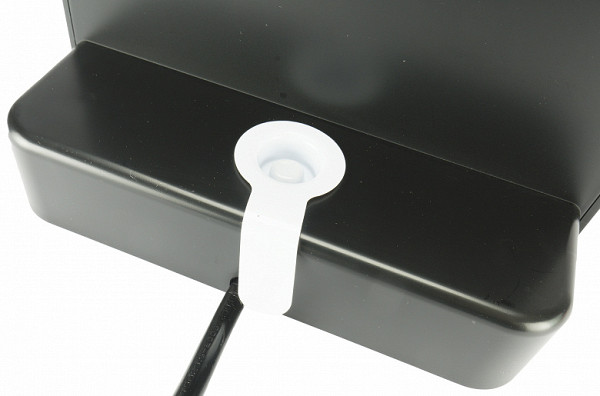
Let's look at the brewing unit. It is made of black matte plastic and has a hinged lid. In the center of the lid is a metal filter with small holes. Under the lid, you can install a removable filter for coffee tablets or an adapter for capsules. Note that the diameter of the pre-filter on the outside (where the water is supplied) is only 12 mm, and on the inside — 25 mm.
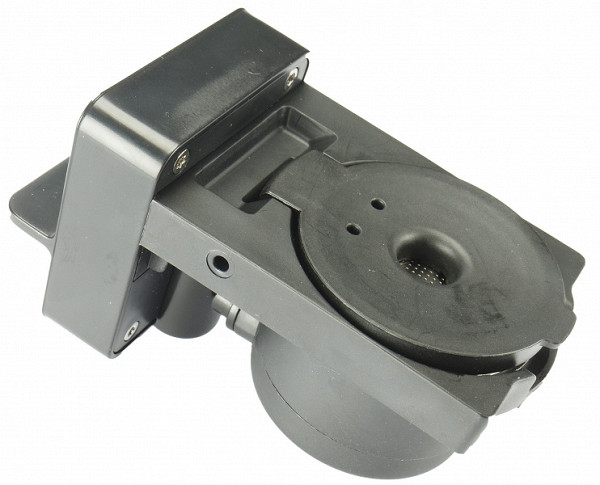
The diameter of the coffee puck is about 45 mm, and we hope that this will not affect the uniformity of the pour and the quality of the coffee brewing.
When preparing coffee, after passing through the coffee puck, the drink enters a small plastic tube, then passes into the spout and through a plastic diffuser — into the cup.
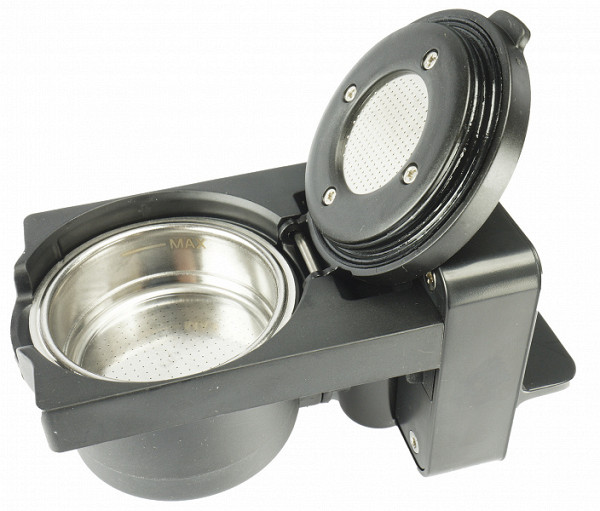
If you do not take into account the absence of the horn itself, then this model is a standard solution for home coffee makers with a filter diameter of 51-52 mm. The kit includes two filters, designed for making one or two cups of coffee, respectively.
The filters in this coffee maker are equipped with a double bottom, which helps to compensate for possible user errors and evens out the taste of coffee, even if the grind or dosage is chosen incorrectly. On one side of the filter there are many small holes, on the other — only one, which contributes to additional foaming of the coffee and the formation of cream. However, the result may not always be completely authentic.
The coffee is served through one spout with a plastic diffuser, so the coffee maker only makes one cup per cycle.
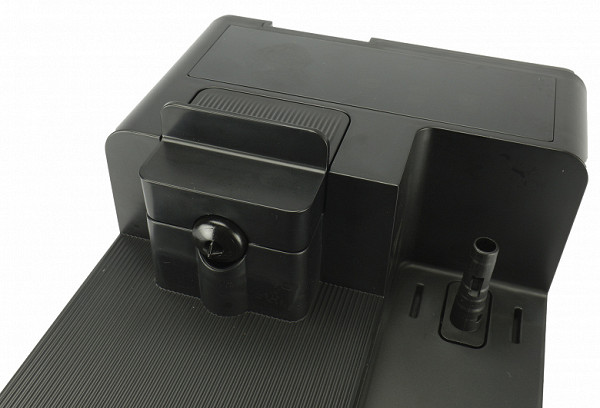
The plastic tamper, which on the other hand serves as a measuring spoon, has no special differences and functions. Although it is preferable to use a special metal tamper (which can be found, for example, on Aliexpress), the plastic version is quite suitable if there is no other tool at hand.
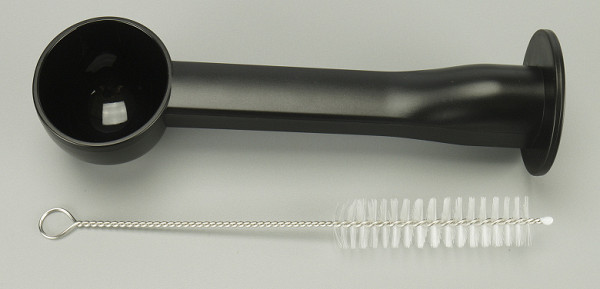
The coffee maker weighs slightly more than average – about 5 kg.
Instructions
The user manual is supplied as a small 40-page booklet and a short version in the form of an A5 cardboard brochure (for easy storage at hand). The information is presented in accessible language, and the printed materials stand out for their thoughtful style and thoughtful presentation.
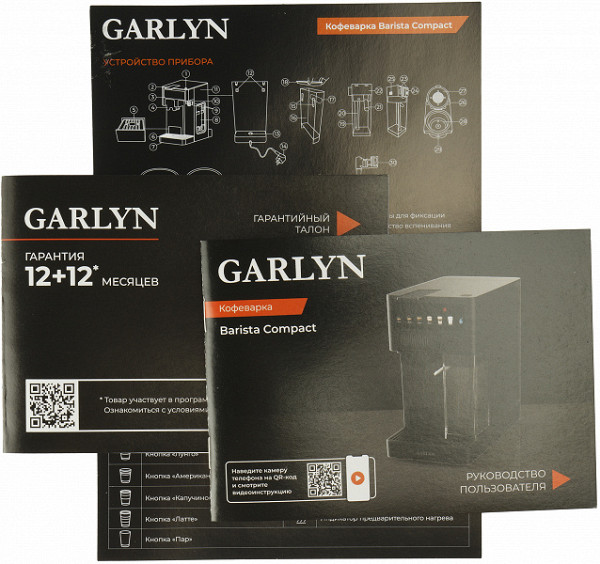
As usual with Garlyn, the instructions are simple and clear. All the information is clearly structured, presented in simple language and accompanied by clear illustrations. Using such a brochure is a real pleasure.
Control
The coffee maker is equipped with six touch buttons on the display and four indicators that signal the current status of the device or possible malfunctions. Each touch button has a colored pictogram, which allows you to intuitively understand its purpose. However, for complete confidence, it is better to refer to the instructions.
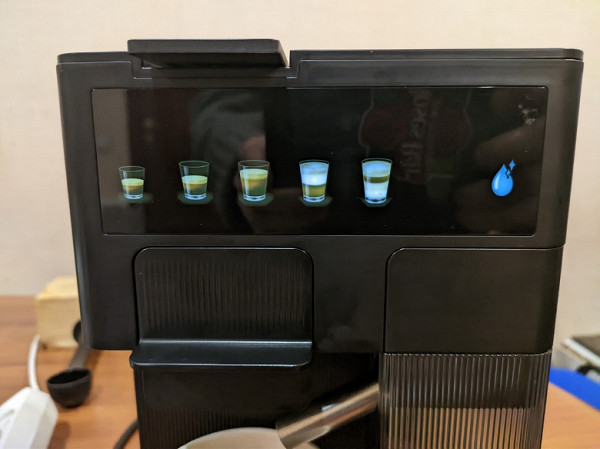
Let's look at the functions of the coffee maker's buttons and indicators.
Buttons:
- Espresso — makes a single portion of espresso. Double-pressing switches to the portion setting mode.
- Lungo — the same espresso, but with an increased pouring time. Double-press to set.
- Americano — a combination of espresso and hot water. Double-pressing allows you to set the volume.
- Cappuccino — espresso with frothed milk. Double-pressing to adjust the milk volume.
- Latte — espresso with frothed milk. Double-pressing to adjust the milk volume.
- Steam — steam supply for working with a hand steamer.
- Cleaning — short press to clean the jug, long press to start the descaling procedure.
Indicators:
- Descaling — indicates the need for descaling after 50 liters of coffee or 5000 seconds of foaming system operation.
- No portafilter — indicates that the portafilter is missing or the lever is not lowered.
- No water — indicates an empty water tank.
- Preheating — indicates that the device is heating up.
Drink adjustments:
- Espresso — 30–100 ml (default 40 ml).
- Lungo — 60–200 ml (default 130 ml).
- Americano — 110–180 ml (default 150 ml).
- Cappuccino — coffee 30–100 ml, milk 40–250 ml (default 40 and 60 ml respectively).
- Latte — coffee 30–100 ml, milk 80–250 ml (default 40 and 100 ml respectively).
Cappuccino and latte settings allow you to separately adjust the volume of milk foam and coffee. To do this, you need to start the setting, wait for the desired volume of milk to be supplied, then start and stop making coffee.
All actions are accompanied by sound signals.
Operation
Before first use, it is recommended to wipe the body of the coffee maker with a damp cloth, and wash and dry all removable parts. These are standard steps for preparing the device for operation.
The device is intuitive and easy to operate. The bright and colorful display makes the icons easy to distinguish, and the buttons work correctly — it is better to press the bottom of the icons for optimal response.
The start and end of programs, as well as various notifications, are accompanied by sound signals. The signal is single or multiple, not too loud, but clearly audible, which does not cause discomfort and does not disturb others.
Separately, it is worth noting the presence of two cup stands. This convenient solution allows you to comfortably use both small espresso cups and large ones for milk drinks.
Overall, using the coffee maker left a positive impression. We will tell you more about the quality of drinks and the features of the programs in the «testing» section.
Care
The body of the coffee maker can be cleaned with a damp cloth, using mild detergents to remove stains if necessary.
The filter and brewing unit should be rinsed under running water and air-dried after each use.
The milk frothing system should be cleaned after each preparation of drinks such as latte or cappuccino, and after using the steamer. To do this, place a container under the spout and press the «Clean» button. The coffee maker will automatically run the required amount of water through the system.
The milk tank, feeding tube and milk froth spout should be cleaned after each use of latte or cappuccino. In practice, you can prepare several cups in a row without additional cleaning, but if the break between drinks is significant, cleaning is recommended.
To clean the cappuccino maker, disconnect the automatic frothing system, remove the tank lid by pressing the release button, empty and rinse the tank. Detach the spout and rinse it under running water. Use a thin object, such as a needle, to clean the milk inlet and outlet holes.
The steamer must be cleaned after each use. Remove the metal casing, rinse it, and clean the hole with a thin object if necessary.
The drip tray must be emptied and rinsed as it fills.
Descaling is done using a special program. Add descaling agent or citric acid to the water tank in a proportion of 10 g per liter of water.
Our measurements
In standby mode, the coffee maker consumes approximately 0.5 watts. During the initial warm-up, which takes about 40 seconds, the power of the device reaches 1090 watts. Additional warm-up until steam can be supplied takes about 15 seconds. Peak power consumption is recorded at 1240 watts.
The overall power consumption of the device is low: for making several cups of coffee, it is measured in tenths of a kilowatt-hour. Therefore, its impact on the electricity bill is insignificant compared to the price of coffee.
Practice tests
During the testing, we prepared several drinks using standard programs and assessed their quality.
First, we prepared a single espresso. A single filter filled to the Max mark holds about 7 g of coffee, which is in line with our expectations. The coffee maker uses pre-wetting: it supplies water for a couple of seconds, pauses briefly, and then pours out the main volume of hot water.
At the factory settings, a single espresso is prepared in 33 seconds, during which time the coffee maker pours about 40 g of the drink. This amount is more than is required to obtain a rich espresso.
The temperature of the drink immediately after preparation is 81 °C, which suits us completely.
Let us remind you that for an ideal espresso, the volume of the drink should be approximately 1.8-2.2 times the dosage of coffee, and the pouring time is 25-27 seconds.
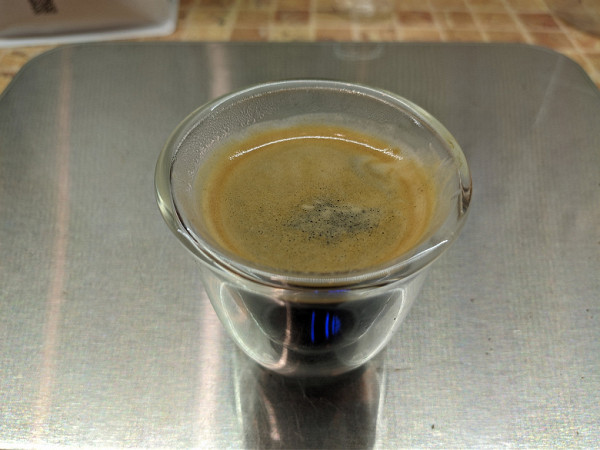
It is not surprising that the finished drink turned out to be quite watery.
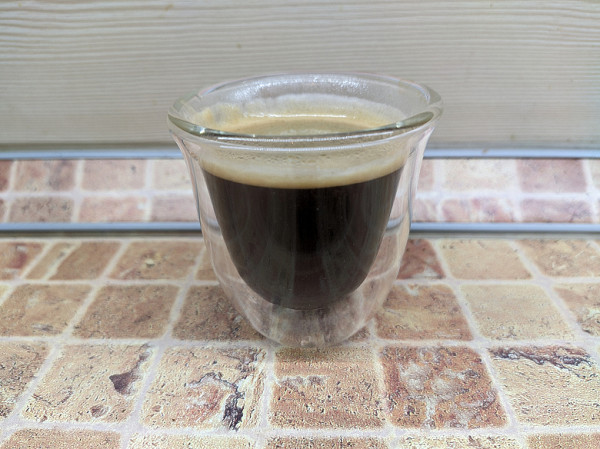
To reduce the volume of the drink, you can try using a finer grind of coffee or adjust the volume of water supply, although the minimum available value will still remain above 30 ml.
It is worth noting that single espresso is not the strong point of budget coffee makers. Therefore, we decided to use a double filter, which holds about 15 g of coffee, and repeated the test with the «espresso» program.
The result was much better. We got a stable crema foam, which indicates a higher quality of preparation of the drink.
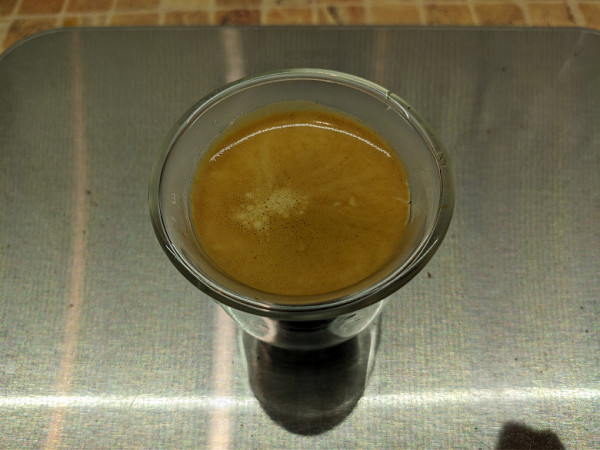
And in general, the finished coffee looks much better, even despite the slight deviation from the desired volume: instead of the desired 30 g of drink, we received 37-41.
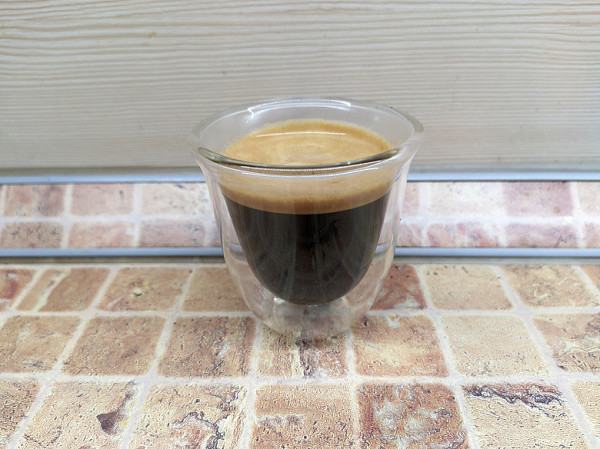
The taste of the prepared drink is slightly different from what we are used to when using a traditional horn coffee maker. In our opinion, coffee from this model has a slight sourness. Those who prefer a more «bitter» taste should take this into account.
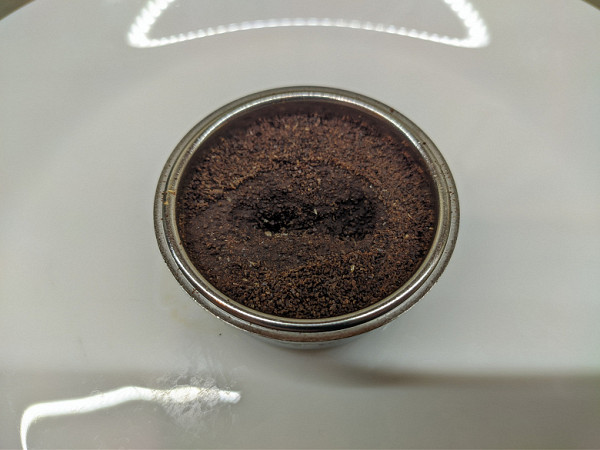
This is due to the specifics of the brewing unit: water is supplied mainly to the center of the coffee tablet. The mesh through which the hot water passes covers only the central part of the filter, which can affect the taste of the drink.
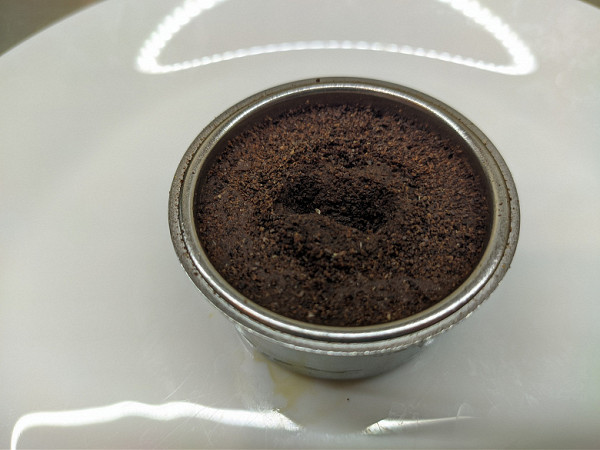
This can be seen by the characteristic depression in the center of the coffee tablet. Let's take another look at the design of the brewing unit to understand why this happens.
The next two modes, Lungo and Americano, are modifications of the same program, but with different volumes of water. In the Lungo mode, we get an increased volume of water pouring through the coffee tablet, while Americano involves adding boiling water to the espresso. However, the coffee maker does not distinguish between these modes and simply supplies water in a volume of 130 ml for Lungo and 150 ml for Americano.
When preparing cappuccino and latte, we also see a similar approach. Cappuccino is prepared by preparing espresso with the addition of frothed milk to obtain approximately equal parts of espresso, milk and milk foam.
If we first froth the milk and add it to the cup, and then prepare espresso, we get a latte macchiato.
In both cases, the coffee maker first dispenses frothed milk and then pours espresso, resulting in two latte macchiatos with different amounts of milk (60 ml for cappuccino and 100 ml for latte). The resulting «cappuccino» looks like this:
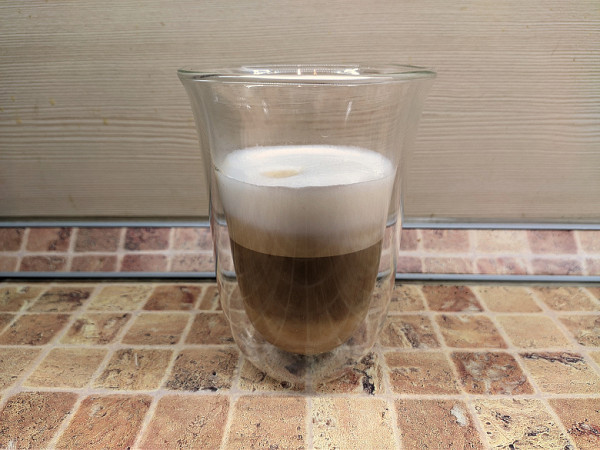
And here's what «latte» is:
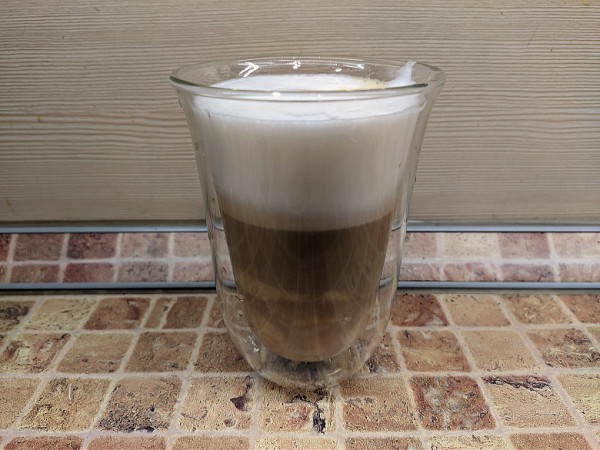
The total weight of the drinks was approximately 140 and 190 g, respectively, and the temperature immediately after preparation was 61-62 °C.
The quality of the foam was assessed as very good: it was stable and without large bubbles.
We found working with a manual steamer not very convenient. The steam is supplied in a powerful stream without the ability to adjust, which leads to the formation of a large number of bubbles and active «bubbling» in the pitcher. Of course, with experience you can master any type of cappuccino maker, but this will require additional practice.
In our case, the question arises whether it is worth spending time on mastering a manual steamer when an automatic jug copes with this task perfectly.
Conclusions
Despite its stylish appearance, the Garlyn Barista Compact coffee maker left us with mixed feelings.
In fact, out of five declared programs, it makes only two types of drinks — espresso/lungo (while Americano is actually also a lungo) and latte in two versions. The difference between latte and cappuccino is only in the ratio of coffee and milk.
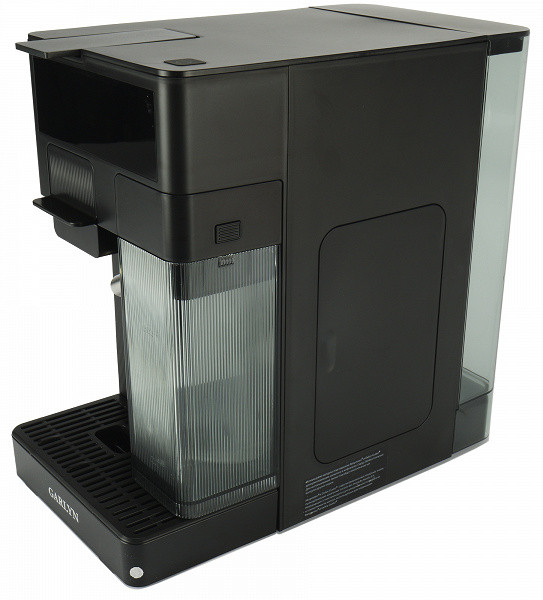
The taste of espresso turned out to be somewhat different from the usual, with a slight bias towards sourness, which is probably due to the non-standard shape of the horn: water is supplied mainly through the center of the coffee tablet.
On the official Garlyn website, you can buy adapters for using Nespresso or Dolce Gusto capsules, each of which costs 1990 rubles. This will expand the capabilities of the device and use capsules of various formats.
Without capsules, the main advantage of this model is the automatic cappuccino jug. In terms of other characteristics, the coffee maker corresponds to other budget models, although it stands out among them with a more attractive design.
Pros:
- stylish appearance
- automatic cappuccino maker
- ability to adjust portion size
- ability to use adapters for working with capsules
Cons:
- minor differences between available programs
- does not make proper cappuccino

